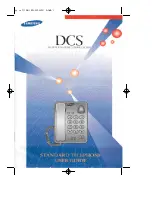
MERLIN LEGEND Communications System Release 5.0
Feature Reference
555-650-110
Issue 1
June 1997
Features
Page 108
Caller ID
Considerations and Constraints
3
General
3
An organization must subscribe to the Caller ID service in order for incoming calls
through the 800 GS/LS-ID port module to receive Caller ID information (loop-start
lines only).
Caller ID/PRI ANI Comparison
3
Caller ID information arrives between the first and second ring at an extension.
PRI ANI uses the second screen of the telephone display to show the called party
number, while Caller ID generally uses this page to display the facility number.
Feature Interactions
3
Conference
The number of participants is shown on Line 1 of the display. The
conference originator can view call information associated with any
participant by pressing the Inspct button and the button the caller is on.
Coverage
Caller ID information is available to users receiving coverage calls.
Display
No Caller ID
is displayed if the call is answered before the Caller ID
data arrives. Calling Party Number information appears in the PRI ANI
format. However, outgoing calling information is not displayed.
Do Not Disturb
Caller ID information is not displayed when a user turns on Do Not
Disturb.
If a user turns on Do Not Disturb while receiving Caller ID information, the
information remains on the display.
Forward and
Follow Me
The systemwide LS-ID delay, if programmed, is in addition to the
Forwarding Delay. The total delay is the LS-ID delay plus the Forwarding
Delay.
Group Calling
Caller ID information appears on the display. Outgoing call information is
not displayed.
Headset Options
When using Headset Auto Answer, program the LS-ID Delay option to
avoid loss of Caller ID information.
Night Service
Caller ID information appears on the display whether or not Night Service
has been activated.
Personal Lines
Caller ID information appears on the display of shared personal lines.
Outgoing call information is not displayed.
Pools
Collisions are avoided on 2-way trunks. Trunks programmed with the
LS-ID Delay option are not seized from a pool for outgoing calls if a call is
coming in on that trunk.
Remote Access
Caller ID information is not retrieved on remote access lines/trunks unless
LS-ID Delay is programmed for the line/trunk because the calls are
answered too quickly.
















































